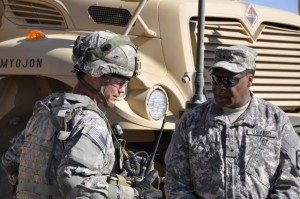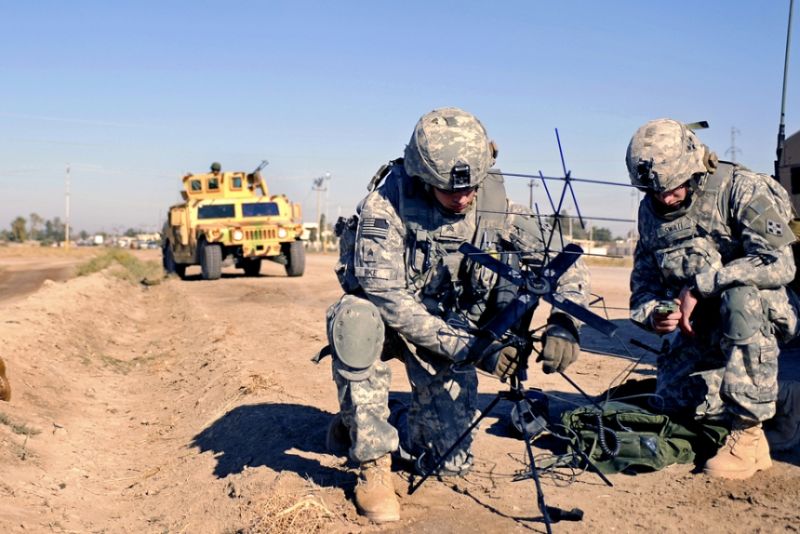The Joint Program Executive Office for Joint Tactical Radio Systems is moving closer to its vision of Cognitive Radio, a concept engineered to allow a family of software-programmable radios to better use portions of the available
spectrum, service officials said.
Cognitive Radio allows Joint Tactical Radio Systems, known as JTRS, radios to more efficiently draw upon high-bandwidth waveforms, ensure maximum interoperability among deployed forces and preserve the security of combat-relevant voice, data, images and video transmitted across the force in real time.
A principle advantage of the JTRS family of radios, which have progressed substantially over more than a decade of technological development, is that they create and sustain secure, mobile, ad-hoc “terrestrial” and “aerial-tier” networks able to safely transmit vital, combat-relevant information across large distances. JTRS radios are engineered to accomplish this by being able to move information across deployed forces potentially located in austere, forward-positioned environments without needing a “fixed” infrastructure such as cell towers or satellite networks.
Each radio functions as a “node” or “router” on the network, extending its reach and mobility across a range of potentially uneven terrain and tactical, combat environments. Security methods such as anti-jam capability and encryption of IP or internet protocol packets of information sent wirelessly through high-bandwidth waveforms such as Soldier Radio Waveform, known as SRW, and Wideband Networking Waveforms, or WNW, are a fundamental element of this equation and a huge priority in the development of JTRS radios.
“With more radios vying for increasing scarce spectrum space, there’s a growing need for cognitive radios that use computer intelligence to automatically and invisibly adapt themselves to user needs and band conditions. Cognitive radio is an umbrella term for an array of different technologies that allow radios to achieve various levels of self-configuration, including automatic operating mode selection, optimal power output and dynamic spectrum access for interference management,” said Brig. Gen. Michael Williamson, joint program executive officer, JTRS.

“DSA allows a JTRS device to sense the available spectrum, discover unused frequencies and adapt to the radio frequency environment, maintaining reliable communications with other DSA-enabled JTRS devices,” he said.
In this respect, the concept of Cognitive Radio envisions a “self-healing,” and “self-adapting” two-way radio able to more efficiently and effectively use limited spectrum while ensuring interoperability and security, he added.
“Cognitive attributes of spectrum ‘sharing’ and ‘agility’ are key to the future. Cognitive Radios are capable of dynamic spectrum utilization that takes advantage of unused channel occupancy or so-called ‘White spaces.’ The challenge is to be able to utilize these channels when they are not occupied and to exit the channel without harm to the channel owner when he turns on. Spectrum sensing is a critical function for future radio systems and JTRS is the platform to deliver capability to the warfighter,” Williamson said.
Both SRW and WNW are high-bandwidth waveforms because they draw upon a larger portion of the available spectrum to more quickly and efficiently transmit information when compared with legacy waveforms; SRW is designed to efficiently use spectrum in 1.2-Megahertz bandwidth allotments. WNW can also support 1.2-Megahertz allotments, but it operates more efficiently and effectively at 3 or 5-Megahertz bandwidth allotments (up to 30 Megahertz when available) to deliver even higher network capacity, said U.S. Navy Capt. Jeffery Hoyle, industry engagement manager, JPEO JTRS.
A key element of the development of JTRS Cognitive Radio is a technique referred to as Spectrum Fragmentation, essentially a method wherein high bandwidth waveforms such as WNW and SRW are able to aggregate smaller chunks of available, unused spectrum into a larger allotment of bandwidth, Hoyle explained.
“Fragmentation allows us to make better use of the spectrum. It will facilitate more optimal spectrum planning and help ensure that we’re getting the best possible use out of the finite spectrum resource in any given geographical area,” he said.
This technique is slated to be demonstrated at one of the Army’s upcoming Network Integration Evaluations at White Sands Missile Range, N.M., in October 2012. These evaluations are designed to further a more “Agile” acquisition process by placing emerging technologies in the hands of Soldiers in a combat-like environment to solicit feedback and perform needed integration, Hoyle said.
The bi-annual planned NIE’s further the goals of streamlining acquisition into a more “Agile Process” in a manner wholly consistent with JPEO JTRS Enterprise Business Model, a developmental method designed, among other things, to allow commercial radio developers to build hardware solutions capable of porting the government-owned non-proprietary waveforms.
“By providing WNW, SRW and other tactical networking software products to industry partners, we enable them to integrate the same capability that we’re currently fielding as part of Program of Record efforts, into their products,” Hoyle added. “Our JTRS Enterprise Business Model enables us to leverage industry’s talents and resources in developing and proving out Cognitive Radio technologies. The Army’s Agile Acquisition process allows the Army to evaluate those industry developments and make faster, smarter decisions regarding which ones to field.”
This process will also help to potentially incorporate industry-developed software enhancements in some cases, Hoyle added.
The JTRS Enterprise Business Model and Cognitive Radio concepts, complete with an emphasis upon security and spectrum “agility,” are fundamental to plans for JPEO JTRS to have industry build a vehicle-mounted radio able to establish mobile, on-the-move communications and transmit information via WNW, officials said.
Through an interactive, collaborative process with its industry partners, JPEO JTRS is solidifying requirements articulated in a draft Request for Proposal for the new MNVR Non-Developmental Item, or NDI acquisition effort designed to capitalize upon the technical progress and innovation realized in the field of software programmable radio over the last decade.
The rationale for this endeavor, which emerged as a result of the termination of the JTRS Ground Mobile Radio, GMR program, is grounded in an effort to leverage the commercial market for more efficient, cost-effective hardware solutions able to utilize the JTRS waveforms,explained Williamson.
Blending commercial-off-the-shelf technologies with established programs of record in order to capitalize upon the latest in technological innovation is an essential aspect of this process, Williamson and Hoyle explained.
At the same time, the proposed MNVR solutions must be able to run the complete complement of the Wideband Networking Waveform WNW which includes both the Orthogonal Frequency Division Multiplexing and the Anti-Jam modes, JPEO JTRS officials explained.
Anti-Jam modes are specifically engineered to protect transmitting information from interference and potentially adversarial efforts to “jam” the frequency signals, and OFDM is a method of enabling multi-path signals to create a gain in signal-to-noise ratios, Hoyle said.
Overall, JTRS Cognitive Radio techniques and the emerging MNVR program are designed to best use finite spectrum resources in order to bring warfighters the substantial tactical and strategic advantage of having secure, interoperable communications and networks, officials said.











